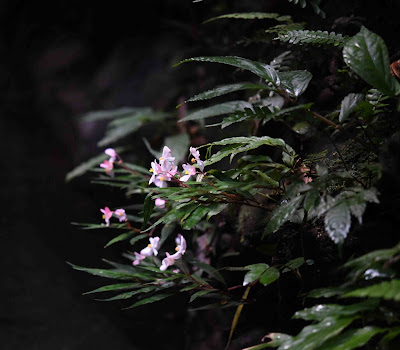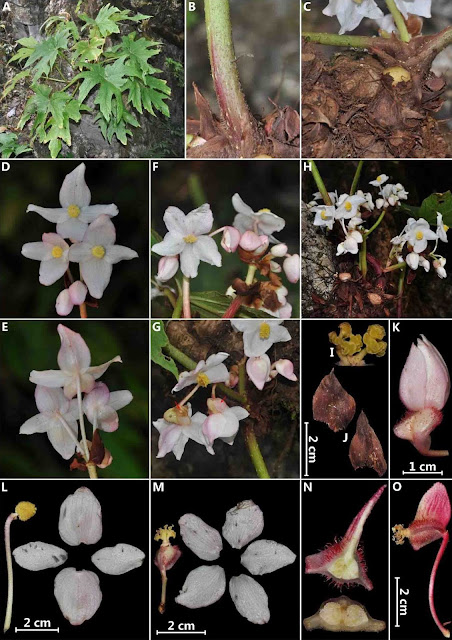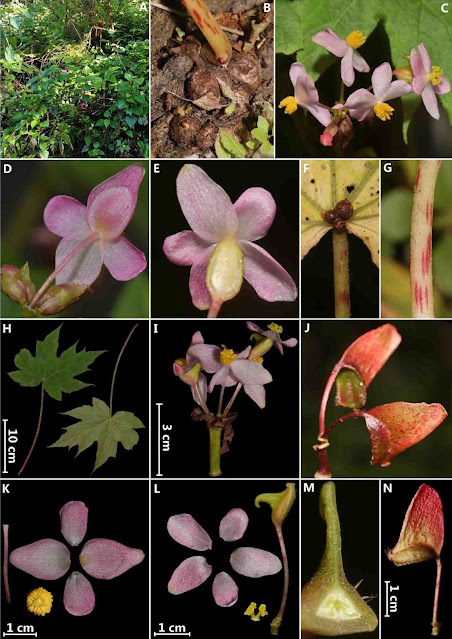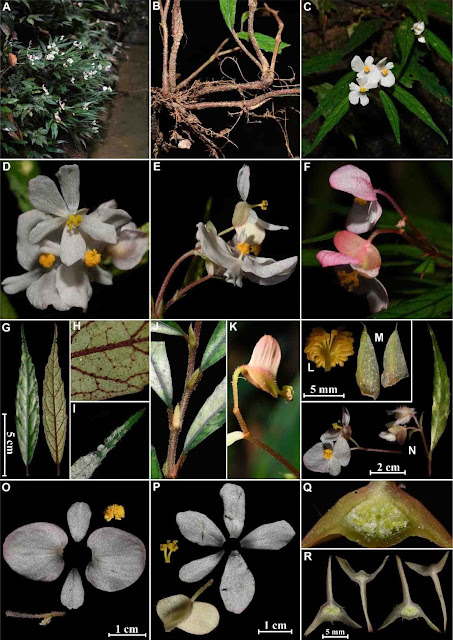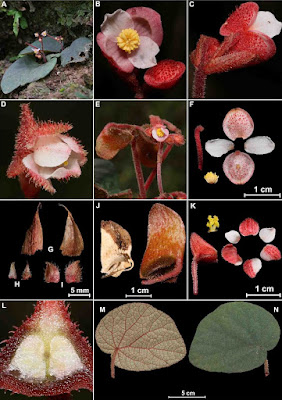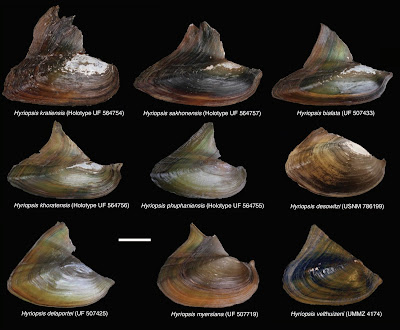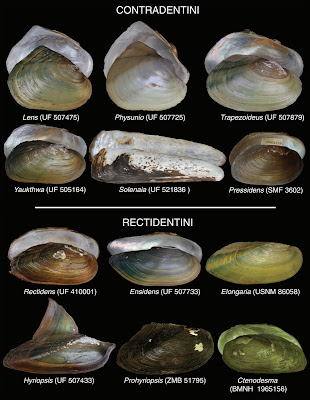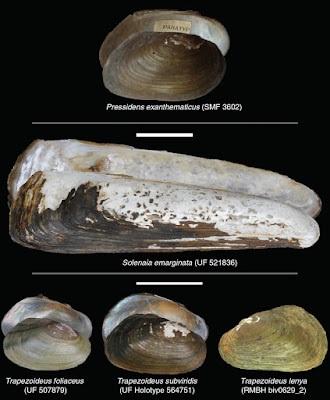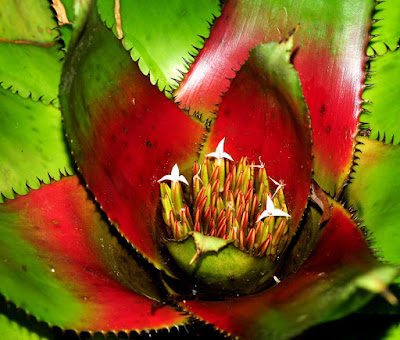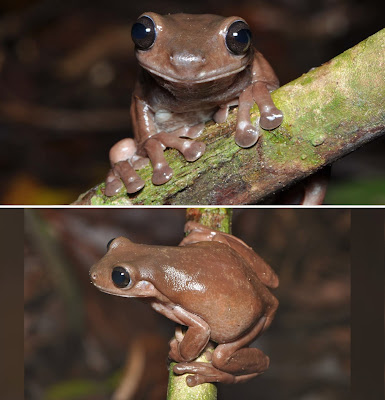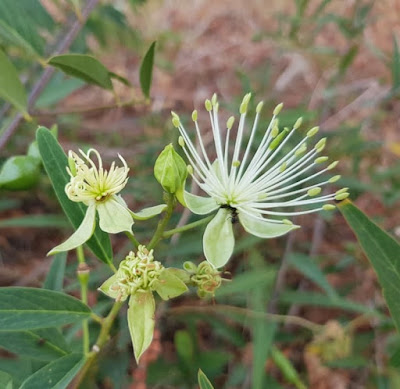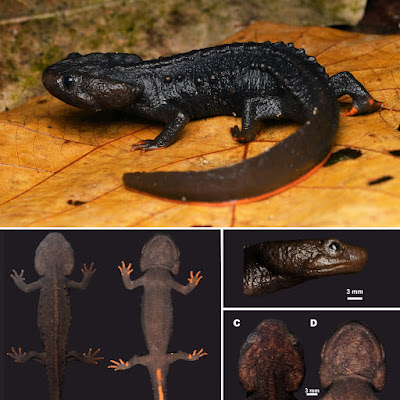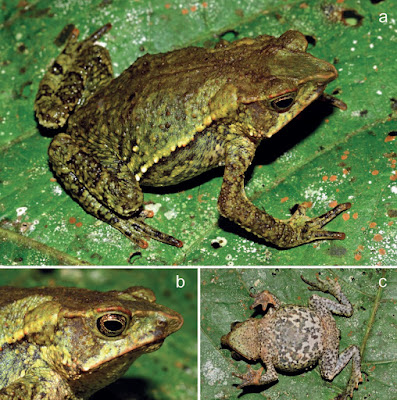[Most Recent Entries] [Calendar View]
Saturday, May 29th, 2021
| Time | Event | ||||
| 2:05a | [Botany • 2021] Taxonomic Studies on Begonia (Begoniaceae) in Myanmar II: Seven New Species from Myanmar Abstract This paper presents the result of consecutive floristic survey in Myanmar. Seven new species of Begonia (Begoniaceae), B. casseabri Y.H.Tan, M.B.Maw & H.B.Ding, B. persistens Y.H.Tan, M.B.Maw & H.B.Ding, B. latibracteata Y.H.Tan, M.B.Maw & H.B.Ding from Putao District, Kachin State, B. natmataungensis Y.H.Tan, M.B.Maw & H.B.Ding from Natma Taung National Park, Chin State, B. amnicola Y.H.Tan, M.B.Maw & H.B.Ding, B. sagaingensis Y.H.Tan, M.B.Maw & H.B.Ding and B. chindwinensis Y.H.Tan, M.B.Maw & H.B.Ding from Htamanthi Wildlife Sanctuary, Sagaing Region, are described and illustrated. All of the new species belongs to Begonia section Platycentrum (Klotzsch) A.DC. Detailed descriptions, colored photographs, habitat and distribution data for the seven new species are provided. A diagnostic key to species of Begonia sect. Platycentrum in Myanmar is presented. Keyword: Begonia Sect. Platycentrum, biodiversity, Myanmar (Burma), bracteole, CAS-SEABRI Begonia casseabri Y.H.Tan, M.B.Maw & H.B.Ding, sp. nov. Begonia Sect. Platycentrum (Klotzsch) A.DC. Diagnosis: Begonia casseabri is morphologically similar to B. dicressine Wahlsteen (2019: 242) from Northern Myanmar under the section Platycentrum. But it can be distinguished from the similar species by lacerate bracteoles under the ovary (vs. without) and tomentose capsule (vs. glabrous). Distribution: This species is known only from the type locality, Putao District, Kachin State, Northern Myanmar (Fig. 8). Ecology: Growing on the granite rocks of tropical montane forest at about 6001200 m altitude. Etymology: The species epithet is derived from the abbreviation of Southeast Asia Biodiversity Research Institute, Chinese Academy of Sciences (CAS-SEABRI); noun in apposition. Vernacular: ြမဧကရီေǤကပန်း (mya ekare kywawy paann). Begonia persistens Y.H.Tan, M.B.Maw & H.B.Ding, sp. nov. Begonia Sect. Platycentrum (Klotzsch) A.DC. Diagnosis: Begonia persistens is morphologically similar to B. rheophytica M.Hughes (in Hughes et al. 2019: 286, Maw et al. 2020) from Northern Myanmar in having symmetric leaves with grooved petiole and with 2 bracteoles under the ovary but it can be distinguished by the following distinct characters including leaf blade broadly oval to ovate, 14–22 × 9–10 cm (vs. narrowly lanceolate, 13.3–18.2 × 2.2–4.0 cm), larger bracteoles under the ovary, 0.8–1.8 × 1–1.4 cm (vs. 0.6−0.8 × 0.3−0.5 cm) and white pilose stipule (vs. glabrous). Distribution: The species can be found only in the type locality, Putao District, Kachin State, Northern Myanmar (Fig. 8). Ecology: Growing on the large rock under light to medium shade of lowland forest at about 500700 m altitude. Etymology: The species epithet ‘persistens’ refers to its persistent bracteoles under the ovary. Vernacular: ပွငခ့် ရံ ွကတ် ညေ် Ǥကပနး် (pwint hkan rwat tai kywawy paann). Begonia latibracteata Y.H.Tan, M.B.Maw & H.B.Ding, sp. nov. Begonia Sect. Platycentrum (Klotzsch) A.DC. Diagnosis: Begonia latibracteata is morphologically similar to B. pedatifida H.Lév. (in Léveillé 1909: 21) in having similar lacerate leaves under the section Platycentrum. But it can be distinguished from the similar species by the following characters: white linear papillae and rusty tomentum on petiole and peduncle (vs. densely or sparsely villous), larger stipules (1.8-3 × 1–1.7 cm vs. ca. 1 × 0.8 cm), with 2 bracteoles under the ovary (vs. without), ovary with densely reddish succulent strigose hairs (vs. glabrous or pilose). Distribution: This species known only from the type locality, Putao District, Kachin State, Northern Myanmar (Fig. 8). Ecology: Growing on rocky slopes in shaded moist environment of tropical montane forest at about 1000 m altitude. Etymology: The species epithet refers to its ovate bracteoles under the ovary. Vernacular: ပွငခ့် ရံ ွကƳ်ကးီေǤကပနး် (pwint hkan rwat kyee kywawy paann). Begonia natmataungensis Y.H.Tan, M.B.Maw & H.B.Ding, sp. nov. Begonia Sect. Platycentrum (Klotzsch) A.DC. Diagnosis: Begonia natmataungensis shares similar morphological characters to B. koelzii R.Camfield (in Camfield and Hughes 2018: 51) in having lacerate leaves with bulbils. But it can be easily distinguished from the similar species by lamina lobes, shallowly incised, divided to 1/31/2 of leaf length (vs. deeply incised, divided to 2/3 of leaf length), without bracteoles (vs. with 2 small bracteoles under the female flower) and styles 2 (vs.3). Distribution: This species is known only from the type locality, Natma Taung National Park, Chin State, Myanmar (Fig. 8). Ecology: Growing on rocky cliffs of evergreen forest at about 1500–3100 m altitude. Etymology: The species epithet refers to its type locality, Natma Taung National Park, Chin State, Myanmar. Vernacular: ေခȆdzǾးစǽမ်ေǤကပန်း (khaw nu m'cong kywawy paann). Begonia amnicola Y.H.Tan, M.B.Maw & H.B.Ding, sp. nov. Begonia Sect. Platycentrum (Klotzsch) A.DC. Diagnosis: Begonia amnicola is mostly similar to Begonia pellionioides Y.M.Shui & W.H.Chen (in Wang et al. 2015: 564) from China (Yunnan) in having erect stem, cauline leaves and elliptic-lanceolate to lanceolate leaves but it can be easily distinguished by the following characters including 2-locular ovary (vs. 3-locular ovary), styles 2 (vs. 3) and unequal wings (vs. equal or slightly unequal wings). Distribution: This species is known only from the type locality, Htamanthi Wildlife Sanctuary, Hkamti District, Sagaing Region, Northern Myanmar (Fig. 8). Ecology: It grows on moist soil nearby or in stream at about 100-200 m altitude. Etymology: The specific epithet refers to the habitat in which this species occurs. Vernacular: ƭကယစ် ငေ် Ǥကပန်း (kyal sin kywawy paann). Begonia sagaingensis Y.H.Tan, M.B.Maw & H.B.Ding, sp. nov. Begonia Sect. Platycentrum (Klotzsch) A.DC. Diagnosis: Begonia sagaingensis is morphologically similar to Begonia menglianensis Y.Y. Qian (2001: 461) from China (Yunnan) in its rhizomatous habit and broadly ovate leaf with densely villous petiole. But it can be easily distinguished by white to pinkish-white flower (vs. pinkish), overlapping leaf base (vs. without overlapping), serrate apex of female flower tepals (vs. entire) and free filaments (vs. fused at base). Distribution: The species is only known from the type locality, Htamanthi Wildlife Sanctuary, Hkamti District, Sagaing Region, Northern Myanmar (Fig. 8). Ecology: The species was discovered on the moist soil slope of deep shaded environment of tropical hill forest. Etymology: The species epithet ‘sagaingensis’ refers to its type locality, Sagaing Region, Myanmar. Vernacular: စစက် င း်ေǤကပန်း (sagaing kywawy paann) Begonia chindwinensis Y.H.Tan, M.B.Maw & H.B.Ding, sp. nov. Begonia Sect. Platycentrum (Klotzsch) A.DC. Diagnosis: The new species is similar to Begonia gulinqingensis S.H. Huang & Y.M. Shui (in Huang & Shui 1994: 334) from China (Yunnan) in the rhizomatous habit, thick texture of leaves and suborbicular shape of leaves, but differs in filaments free (vs. fused at base), styles 2 (vs. 3) and ovary 2-loculed (vs. 3-loculed). Distribution: The new species is only found in the type locality, Htamanthi Wildlife Sanctuary, Hkamti District, Sagaing Region, Northern Myanmar (Fig. 8). Ecology: It grows in cool and moist environment in evergreen forest at about 185 m altitude. Etymology: The specific epithet refers to its type locality, Htamanthi Wildlife Sancturay is one of the key biodiversity area in Chindwin River Basin. Vernacular: ချငး်တငွး်ေǤကပန်း (chindwin kywawy paann). Mya Bhone Maw, Hong-Bo Ding, Bin Yang, Pyae Pyae Win and Yun-Hong Tan. 2021. Taxonomic Studies on Begonia (Begoniaceae) in Myanmar II: Seven New Species from Myanmar. Taiwania. 66(2); 214-231. DOI: 10.6165/tai.2021.66.214 | ||||
| 2:36a | [Mollusca • 2021] Taxonomic Revision of A Radiation of South-east Asian Freshwater Mussels (Unionidae: Gonideinae: Contradentini + Rectidentini) Abstract The tribes Contradentini and Rectidentini (Unionidae) comprise a diverse clade of freshwater mussels endemic to South-east Asia. Our understanding of the diversity and phylogeny of this radiation has improved dramatically in recent years, but this systematic transformation has not yet benefited from comprehensive museum sampling or phylogenomic methods. A synthetic taxonomic revision of the Contradentini+Rectidentini that leverages these useful and accessible methods is needed. We set out to (1) generate a phylogenomic reconstruction of the supraspecific relationships of the Contradentini+Rectidentini using anchored hybrid enrichment, (2) revise the taxonomy and geographic boundaries of the generic and species-level diversity of the radiation, and (3) identify patterns of freshwater mussel diversity and distribution in this clade and discuss the processes that may have precipitated them. Our phylogenomic reconstruction using over 1600 loci, with a total alignment length of over a half a million nucleotides, recovers a well supported phylogeny of the clade that resolves four independent multispecies radiations endemic to the Mekong drainage. We examined, digitised, and imaged 1837 records from 15 natural history museums that provided the necessary data to document the morphological variation and geographic distributions of the focal taxa. We also analysed 860 COI sequences, 519 of which were generated in this study, to better understand the species boundaries and geographic distributions of the recovered clades. We recognise 54 valid species in the tribes Contradentini and Rectidentini, including 9 described herein as new to science. Out of this revision emerged several interesting biogeographic patterns that appear to have resulted from recent stream capture, historical confluence, and intradrainage barriers to dispersal. We hypothesise that these phenomena shaped the diversity and distribution of the Contradentini+Rectidentini, contributing to the formation of several characteristic freshwater mussel provinces in South-east Asia.
John M. Pfeiffer, Daniel L. Graf, Kevin S. Cummings and Lawrence M. Page. 2021. Taxonomic Revision of A Radiation of South-east Asian Freshwater Mussels (Unionidae: Gonideinae: Contradentini+Rectidentini). Invertebrate Systematics 35(4) 394-470. DOI: 10.1071/IS20044 | ||||
| 2:42a | [Botany • 2021] Re-evaluation of the Amazonian Hylaeaicum (Bromeliaceae: Bromelioideae) based on Neglected Morphological Traits and Molecular Evidence
Abstract Generic status for the Amazonian Hylaeaicum is proposed within the Aechmea alliance, excluding it from the “Nidularioid complex” in general and from Neoregelia in particular. The monophyly of this new genus is supported by molecular phylogenetic analyses. The taxonomic circumscription of Hylaeaicum is based on the combination of geographical range and morphological characters, such as clonal growth, inflorescence structure, petal and corolla conformation, petal appendages, ovary, ovule, stigma, pollen, fruit, and seed, as well as seed anatomy, thoroughly documented and illustrated from field-collected specimens that flowered in cultivation in the Rio de Janeiro Botanical Garden, the Marie Selby Botanical Gardens, and in Refúgio dos Gravatás. The presence of seeds with long bicaudate appendages on both chalazal and micropylar ends is reported for the first time in Bromelioideae and considered an important character to distinguish Hylaeaicum from the related genera in the Aechmea alliance. In order to support the morphological distinctness of Hylaeaicum, the most varied and complete documentation of stigmata, fruits, and seeds of Bromelioideae is also presented for the first time, covering 24 genera and 17 subgenera. Fourteen new combinations, including 12 species and two varieties, are proposed. Keywords: Aechmea alliance, morphology, “Nidularioid complex”, baccate fruits, appendaged seeds, Monocots Elton M. C. Leme, Georg Zizka, Juraj Paule, Julián Aguirre-Santoro, Sascha Heller, Ivón M. Ramírez-Morillo, Heidemarie Halbritter, Jorge E. A. Mariath, Jordano D. T. de Carvalho and Rafaela C. Forzza. 2021. Re-evaluation of the Amazonian Hylaeaicum (Bromeliaceae: Bromelioideae) based on Neglected Morphological Traits and Molecular Evidence. Phytotaxa. 499(1); 1–60. DOI: 10.11646/phytotaxa.499.1.1 | ||||
| 2:43a | [Herpetology • 2020] Litoria mira • Multiple Trans-Torres Strait Colonisations by Tree Frogs in the Litoria caerulea Group (Anura: Pelodryadidae), with the Description of A New Species from New Guinea
Abstract Australia and New Guinea (together referred to as Sahul) were linked by land for much of the late Tertiary and share many biotic elements. However, New Guinea is dominated by rainforest, and northern Australia by savannah. Resolving patterns of biotic interchange between these two regions is critical to understanding the expansion and contraction of both habitat types. The green tree frog (Litoria caerulea) has a vast range across northern and eastern Australia and New Guinea. An assessment of mitochondrial and morphological diversity in this nominal taxon in New Guinea reveals two taxa. True Litoria caerulea occurs in disjunct savannahs of the Trans-Fly, Central Province and across northern Australia, with very low genetic divergence, implying late Pleistocene connectivity. A previously unrecognised taxon is endemic to New Guinea and widespread in lowland swampy rainforest. Date estimates for the divergence of the new species suggest Pliocene connectivity across lowland tropical habitats of northern Australia and New Guinea. In contrast, the new species shows shallow phylogeographic structuring across the central mountains of New Guinea, implying recent dispersal between the northern and southern lowlands. These results emphasise that the extent and connectivity of lowland rainforest and savannah environments across northern Australia and southern New Guinea have undergone profound shifts since the late Pliocene. Keywords: Australian Monsoonal Tropics, biotic exchange, Litoria caerulea, Litoria mira sp. nov., New Guinea, rainforest, Sahul, savannah, Trans-Fly, tree frog.
Litoria mira Oliver, Rittmeyer, Torkkola, Dahl, Donnellan & Richards, sp. nov. Chocolate Tree Frog Litoria caerulea Tyler (1968 in part) Litoria caerulea Dahl, Richards & Novotny (2013) Diagnosis: Litoria mira can be distinguished from all other Litoria by the unique combination of moderately large size (male SUL up to 70.8, female SUL up to 79.6 mm); vomerine teeth present; webbing on hand extending no further than base of penultimate phalanx on fourth finger; limbs without prominent white or yellow lateral folds or ornamentation; lip lacking a white stripe; limbs relatively short and robust (TL/SUL 0.41–0.48); parotoid gland present, but not prominent and not fused with prominent gland on top of head; head relatively narrow (HW/ HL 0.91–1.0), distinctly tapering from body; dorsal colouration uniformly brown, without white or yellow spots; small violet patch of skin at postero-ventral edge of eye; and ventral surfaces of limbs, torso and throat with moderate to extensive regions densely stippled with dark to medium brown. Etymology: The name mira is the feminine form of the Latin adjective mirum, for surprised or strange, stemming from our surprise in discovering an undescribed member of the predominately Australian L. caerulea group occurring widely across lowland swampy rainforest in New Guinea. Paul M. Oliver, Eric N. Rittmeyer, Janne Torkkola, Stephen C. Donnellan, Chris Dahl and Stephen J. Richards. 2020. Multiple Trans-Torres Strait Colonisations by Tree Frogs in the Litoria caerulea Group, with the Description of A New Species from New Guinea. Australian Journal of Zoology. 68; 25–39 . DOI: 10.1071/ZO20071 Sweet new discovery – a new species of chocolate frog | ||||
| 2:46a | [Botany • 2021] Maerua koratensis (Capparaceae) แจงสุรนารี • A New Species from eastern Thailand
Abstract A new species, Maerua koratensis (Capparaceae), only known from a restricted locality in Nakhon Ratchasima Province, eastern Thailand, is here described and illustrated. This is the second species of Maerua to be described from South-East Asia. This new species is distinguished by the simple leaves, petaliferous flowers with distinctly 4-lobed laciniate disc, and cylindrical, torulose to moniliform fruits. Morphological characteristics of M. koratensis and M. juncea subsp. juncea, its most similar, are compared. A key to the Maerua species occurring in mainland South-East Asia is provided. Keywords: Capparaceae, Maerua, Nakhon Ratchasima, South-East Asia, taxonomy, Eudicots Maerua koratensis Prachaya Srisanga, Nooduan Muangsan, Thiamhathai Choopan, Jakrapong Thangthong, Ratchada Pratcharoenwanich and Santi Watthana. 2021. Maerua koratensis (Capparaceae), A New Species from Thailand. Phytotaxa. 498(3); 213–219. DOI: 10.11646/phytotaxa.498.3.7 | ||||
| 8:02a | [Herpetology • 2021] Tylototriton thaiorum • A New Species of the Genus Tylototriton (Caudata: Salamandridae) from Central Vietnam Abstract We describe a new species of the genus Tylototriton from Pu Hoat Nature Reserve, Nghe An Province, in the northern part of Central Vietnam, based on morphological and molecular evidence. The new species was previously confused with T. vietnamensis from northern Vietnam and T. notialis from Laos. The new species can be distinguished from T. notialis by the absence of orange coloration on posterior end of parotids (vs presence); an indistinct brown coloration on rib nodules (vs bright orange); a broader and slightly rounded head (vs narrower and angular); comparatively shorter limbs (vs longer); slightly fewer number, smaller size and irregular arrangement of rib nodules (vs larger rib nodules arranged in two dorsolateral series). Phylogenetic analysis of the ND2 and 16S rRNA mtDNA genes confirmed the placement of the new species to Clade I of the subgenus Yaotriton, and suggests it is a sister species of T. notialis (p-distance 3.0% in ND2 gene). The range of the new species is restricted to the Pu Hoat Mountain Range and is isolated from the range of T. notialis, which inhabits Northern Annamites (Truong Son) Mountains by the valley of the Ca River, an important biogeographic barrier. The new species is currently known only from the montane forests of Pu Hoat Nature Reserve (at elevations from 700 to 1000 m a.s.l.). We suggest the new species be classified as Endangered (EN) on the IUCN Red List. Key words: Tylototriton thaiorum sp. nov., mtDNA genealogy, Pu Hoat Nature Reserve, Ca River
Salamandridae Goldfuss, 1820 Tylototriton Anderson, 1871 Tylototriton thaiorum sp. nov. Tylototriton vietnamensis — Böhme et al. 2005 [partim] Tylototriton notialis — Nishikawa et al. 2013b [partim], Phimmachak et al. 2015 [partim], Yang et al. 2018 [partim], Than Zaw et al. 2019 [partim], Bernardes et al. 2020 [partim] Diagnosis. The new species is assigned to the genus Tylototriton and the subgenus Yaotriton based on the results of the molecular phylogenetic analyses and the following combination of morphological attributes: presence of dorsal granules, dorsolateral bony ridges on head, presence of dorsolateral series of knob-like warts (rib nodules), and absence of quadrate spine (Figs. 3–5). Tylototriton thaiorum sp. nov. is differentiated from all other members of the subgenus Yaotrion by the following combination of morphological characters: medium body size (SVL 59.3–68.6 mm in males); snout obtusely rounded in dorsal view and in lateral profile; skin rough with fine granules; supratemporal bony ridges on head wide, slightly protruding, beginning at the anterior corner of orbit; sagittal ridge on head low and almost indistinct; limbs thin, tips of forelimb and hindlimb overlapping when adpressed along body; vertebral ridge distinct, rough, not segmented; rib nodules 10–14, small, poorly distinct, arranged in two irregular dorsolateral series intermittent with smaller warts; dorsal background coloration dark-brown, ventral coloration greyish brown, limbs blackish; fingers and toe tips, parts of soles and palms, and vent bright orange, orange stripe continuing along the ventral edge of tail to the tail tip. Etymology. The specific name ―thaiorum is a Latin adjective in the genitive plural (masculine gender), derived from the name of the T[h]ai people who inhabit the montane areas of northern Vietnam and adjacent territories, including the type locality of the new species. The people of Muong Dan Village pointed out to us the breeding habitat of the new species. We suggest the following common names: Thai Crocodile Newt (English), Cá cóc thái (Vietnamese), Taiskiy krokodilovyi triton (Russian). Nikolay A. Poyarkov, Tan Van Nguyen and Dmitriy V. Arkhipov. 2021. A New Species of the Genus Tylototriton (Amphibia: Caudata: Salamandridae) from Central Vietnam. TAPROBANICA. 10(1); 4–22. DOI: 10.47605/tapro.v10i1.244 | ||||
| 9:27a | [Herpetology • 2021] Rhinella chullachaki • Genetic and Morphological Evidence reveal Another New Toad of the Rhinella festae Species Group (Anura: Bufonidae) from the Cordillera Azul in central Peru
Abstract We studied the status of toads of the genus Rhinella collected in the southern Cordillera Azul, central Peru. Molecular analysis of the mitochondrial 16S rRNA gene revealed them to be members of the recently proposed Rhinella festae species group, and sister to R. lilyrodriguezae, a species known from northern areas of the Cordillera Azul. The new specimens are differentiated from R. lilyrodriguezae and other species of Rhinella by substantial genetic divergence in the studied gene fragment (> 5% uncorrected pairwise distance) and several qualitative morphological characters, providing combined evidence for a divergent evolutionary lineage. We consequently describe the specimens from the southern part of the Cordillera Azul in Departamento Huánuco as a new species, Rhinella chullachaki sp. n. We briefly discuss the definition and content of species groups in Rhinella as well as the difficulties hampering taxonomic resolution within this species-rich genus. Key words. Amphibia, Rhinella, new species, species groups, morphology, molecular genetics, systematics, taxonomy.
Rhinella chullachaki sp. n. Diagnosis. A medium-sized species of the Rhinella festae species group, based on morphological similarities and phylogenetic relationships. The new species is characterized by (1) medium size, SVL 42.1–44.2 mm in adult males (n = 3), females are unknown; (2) eight presacral vertebrae; (3) bicondylar articulation of sacral vertebrae and coccyx; (4) snout long, acuminate, pointed to rounded terminally in dorsal view; snout protuberant, directed slightly anteroventrally in profile as a ‘shark snout’; nostrils at level or only slightly beyond anterior margin of lower jaw in lateral profile; (5) cranial crests moderately developed; (6) canthal, supraorbital, postorbital and supratympanic crests distinctly elevated and continuous; pretympanic crest present, occipital crest weakly developed; (7) tympanum and tympanic annulus absent, middle ear cavity and columella present; (8) mandibular angle protruding; (9) parotoid glands moderately large, roughly rectangular and rounded in outline, swollen laterally, incorporated into the lateral row of tubercles; (10) dorsolateral rows of large, conical tubercles extending from parotoid gland to groin; (11) hands and feet with long digits, fingers basally webbed and toes moderately webbed; (12) skin on dorsum tubercular with scattered large tubercles in the lateral and lumbar regions in males; (13) subarticular tubercles distinct, round to ovoid; (14) supernumerary tubercles present, round and well developed; (15) cloacal sheath absent; (16) in life, dorsum yellowish green with irregular black and dark brown markings; venter pale cream to white with black blotches and spots; black spots and flecking on ventral surfaces of limbs and scattered black spots on throat; iris bronze with irregular black reticulation. ... Etymology. The specific epithet is derived from the Quechuan language. The Chullachaki is a mythical creature of the Peruvian and Brazilian Amazon region said to be living in the jungle, being able to turn into any creature, and guarding the forest by punishing people acting unwisely in the forest. Many depictive representations of the Chullachaki show it as having a large nose. We chose the name as a plea for a more respectful and sustainable treatment of Peruvian forests. The specific name is an invariable noun in apposition. Proposed common names. Chullachaki Beaked Toad; Sapo picudo Chullachaki. Ernesto Castillo-Urbina, Frank Glaw, César Aguilar-Puntriano, Miguel Vences and Jörn Köhler. 2021. Genetic and Morphological Evidence reveal Another New Toad of the Rhinella festae Species Group (Anura: Bufonidae) from the Cordillera Azul in central Peru. SALAMANDRA. 57(2); 181-195. |
| << Previous Day |
2021/05/29 [Calendar] |
Next Day >> |
